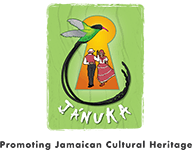Background music to our quadrille dance:
The musical accompaniment to our quadrille dance is a lively mixture of traditional, contemporary and popular music with the appropriate rhythm and beat and aesthetically acceptable lyrics. This include 20th Century mento, gospel and dance hall genres.
A variety of background music help to engage and maintain audience interest, as it highlight the fact that Camp Style quadrille is not static but constantly evolving. It can be danced to music of all times, from different cultures, and generations as long as it is lively!
However the “Mento” music, the original music of Jamaica, is our base music and so several of our quadrille movements are choreographed to this rhythm and beat. For example, Rucumbine, Wheel and Tun mi, Dog war, Hill and Gully Ride, In a mi Prime.
We chose mento because our African- Jamaican ancestors, some of whom were self taught slave musicians, developed rudimentary musical instruments from natural resources found on the island to create this authentic and distinctive musical sound.
They were able to instinctively reproduced their African rhythm and beat (humming, chanting and drumming) through these instruments, and accompanied the sounds with a call response and repetitive style of harmonised singing and dancing that was common in Africa.
They demonstrated knowledge and love of music, their creative spirit, their flexible and adaptive qualities in the production of Mento, and we are proud of them.
The African rhythm and beat in the Mento helped to nurture and maintain links with their cultures and homeland. The sounds awakened fond memories of music and dance that they could enjoy together in their limited spare time and in support for their communities during periods of stress and bereavement.
During the 1950s Mento music was used humorously to communicate topical issues about social, economic, religious, sexual and political life in Jamaica, and in rural areas this was an important medium of communication with the outside world.
In relation to quadrille mento music, a blend of both Jamaican Mento and European orchestral elements are observed. This blending could have developed when European musicians were not available on the island and slave musicians were asked to provide the live musical accompaniment to the European ballroom quadrille, danced in the Great houses.
As well as doing their own thing, playing mento, the slave musicians also had to provide music with a more European tempo and beat (slower pace and quieter background drumming) to please their slave masters’ musical taste.
Musical instruments were further developed, refined and added over the years as the musicians became more sophisticated and began forming Mento bands. Rudimentary instruments included:
- Kerosene tin
- Iron Dutch pot covers
- Benta made from Bamboo
- Gourd
- Catta Sticks
- Rhumba Box – made from ply or cedar wood with tunes metal tins – the Baas of the music
- Shakas (Maracas) – from gourd, seeds, beads, and sticks
- Grater – played with knife, spoon or fork
- Tambourine
- Drums – variety of drums made from wood and animal skin
- Bamboo saxaphone
- Fiddle
- Fife
- Horse or donkey jaw bone
- Cow horn
- Whistle
- Guitar
- Harmonica
P.S. Recorded Mento music became popular in Jamaica in the 1950s and a lot of information about it and the musicians who created it can be accessed from the web.
From Bev (March 2013)




















